THE THREE METHODS OF SPARKLING WINEMAKING
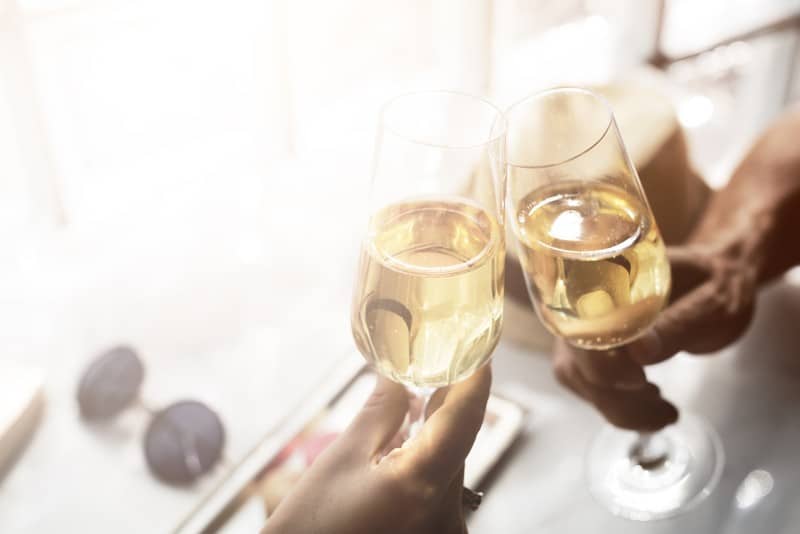
Fizz, pop, clink, sip. This ritual is one bubbly-lovers hold sacred, and many look to Champagne for their fizzy fix. Made with mainly Chardonnay grapes, Blanc de Blancs from Champagne has enjoyed a lifetime of prestige, so much so that many French Champagne houses have grown to be international brands whose wine is made on multiple continents, including our own.
What few realize is that German winemakers have been making sparkling wine, or Sekt, in an off-dry style, using affordable varieties from more economical regions such as Muller-Thurgau. Most producers of the boozy bubbly beverage use the economical Tank Method (like Prosecco). Larger houses (rarely in Germany) produce their bubbly through the slightly more complex transfer method. Less use high-quality and pricey Riesling grapes and lesser still use the labor-intensive and time-consuming traditional method of production. So what exactly are the differences between the three methods of sparkling wine production? In the first of a three-part series, we’ll break down the three most commonly-used means of production.
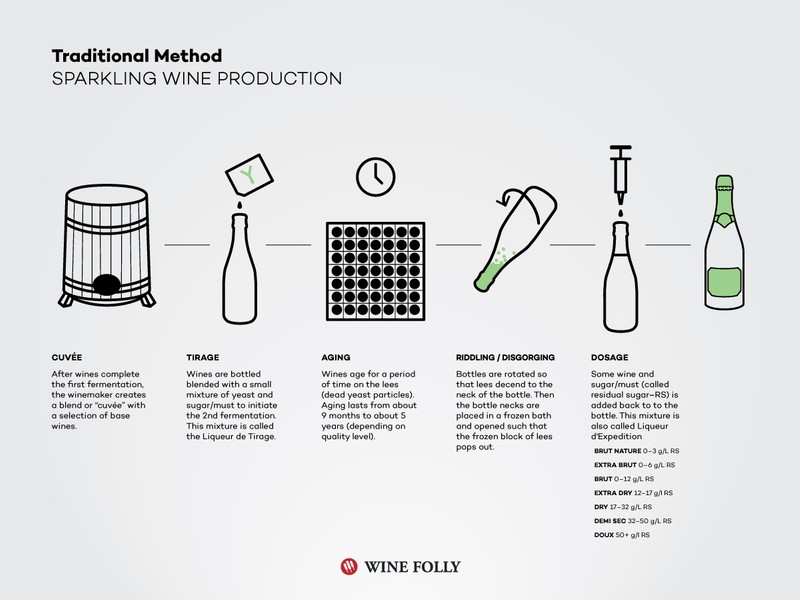
Photo Credit: Wine Folly
TRADITIONAL METHOD
The Traditional Method of sparkling winemaking goes by many names: Méthode Champenoise, Méthode Traditionelle, Méthode Cap Classique, to name a few. Whatever the alias, the finished products are some of the most celebrated due to the sheer amount of time, labor and money that went into their creation. The most magical part? The entire transformation from still to sparkling wine takes place inside the glass walls of each bottle.

BASE WINE
First, grapes are picked (usually sooner than grapes used solely for still wines, to preserve acidity) and fermented to dry as usual. The winemaker blends multiple base wines together to create a cuvée (blend).
TIRAGE
Next, the base wine is bottled and a precise mixture of yeast, wine, and sugar called liqueur de tirage is added to the base wine to each bottle, which are capped with a crown cap (like a beer bottle). This triggers the second fermentation.
SECOND FERMENTATION
The second fermentation creates about 1.3% more alcohol and carbon dioxide, and spent yeast cells that remain in the bottle.
AGING
The wine is then left to age on these spent yeast cells, or lees (sur lie, or en tirage) to develop texture, complexity, and autolytic character in the wine. This process is entirely subjective and can be anywhere from 9 months to 5 years, depending on quality. Many believe the longer the wine rests on the lees, the better.
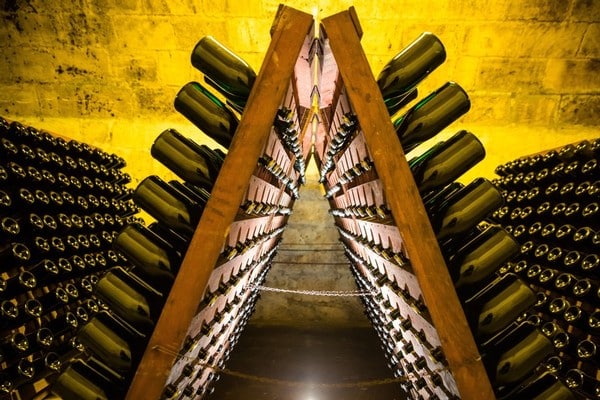
RIDDLING
Once the winemaker decides the wine is close to finished, it’s time to Riddle! Riddling traditionally takes place in riddling racks; rectangular wooden boards hinged at the top, both sides with holes to hold the necks of bottles. The bottles are placed neck-down into the racks at a 45-degree angle. Every day for several weeks, the riddler rotates every single bottle a few degrees, gently shifting the lees closer to the neck of the bottle. At the end of the process, the bottles are slanted a 60-degree angle and are completely neck-down in their holes, and all the lees are collected in the neck.
DISGORGEMENT
This process removes sediment from the bottle without wasting wine or compromising quality. After riddling, bottles are placed upside-down into a freezing solution for several minutes which causes the residual yeast particles to freeze. The crown caps are then popped off which allows the frozen plug of lees to shoot out. The minimal amount of wine lost in the process is replaced with a slightly sweet mixture of wine and sugar, or dosage, which balances the acidity in the wine.
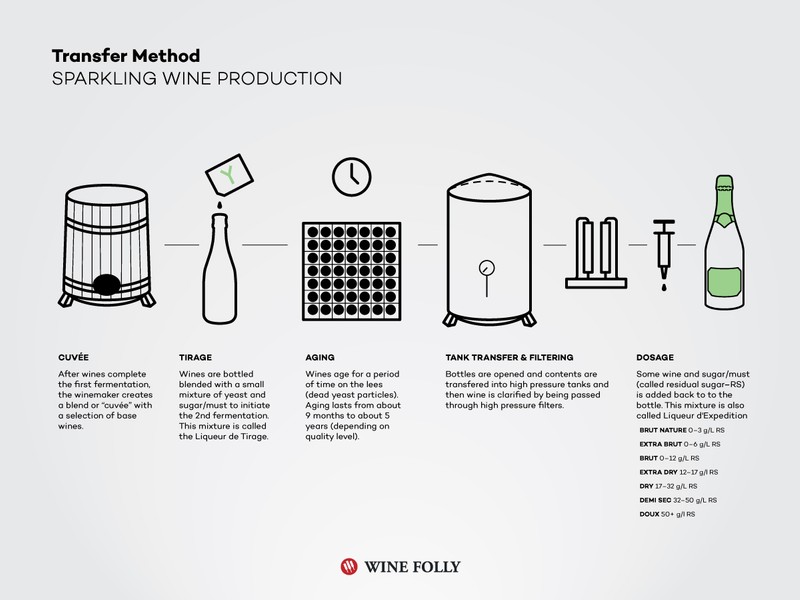
Photo Credit: Wine Folly
TRANSFER METHOD
The transfer method is identical to the traditional method until the aging process is complete. After aging, the bottled wines are emptied into a large, pressurized tank and filtered immediately to separate the lees from the wine. This method sidesteps the costly and difficult riddling and disgorgement of the traditional method, yet the resulting wines still may have delicious autolytic flavors and textures.
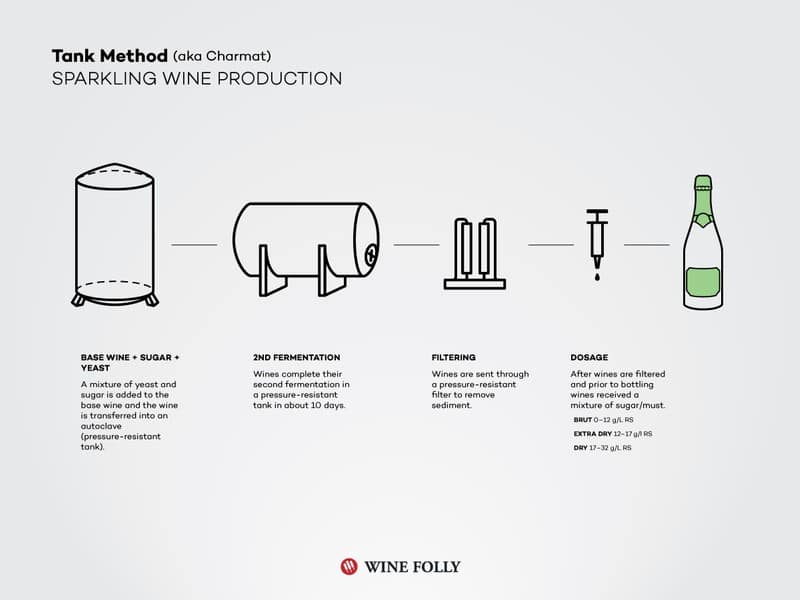
Photo Credit: Wine Folly
TANK METHOD
Also known as the Charmat Method, the tank method tends to be the fastest and most affordable and uses (you guessed it) a stainless steel tank to turn a still base wine into a sparkling one, rather than a bottle. Finished wine is added together with liqueur de tirage, a sugar, wine, and yeast mixture, triggering a rapid fermentation within the pressure-resistant tank.
As the fermentation goes on, carbon dioxide released from the fermentation causes the tank to pressurize, and the resulting sparkling wine is filtered, dosed with a solution of sugar and wine, and bottled.
Wines made using the tank method are inherently fresher in character as they are not aged at all. Large-volume producers of sparkling wines around the world utilize this method as it allows for the quickest turnaround (approximately 10-12 days from base wine to bottle) of the three methods.
